
Beowulf is an epic poem that is considered one of the greatest works of Old English literature. It tells the story of a hero, Beowulf, who comes to the aid of the Danish king Hrothgar, whose kingdom is plagued by a monster named Grendel. Throughout the poem, Beowulf displays his bravery, strength, and honor as he battles not only Grendel, but also Grendel’s mother and a dragon.
As you read Beowulf, you may have several questions and seek answers to better understand the poem. This reading guide aims to provide you with answers to some of the commonly asked questions about Beowulf. It will cover topics such as the historical context of the poem, the characters and their motivations, and the themes and symbolism present in the story.
Understanding Beowulf requires delving into the world of Anglo-Saxon culture and mythology. This reading guide will explore the societal structures, values, and beliefs that influenced the characters and events in the poem. Additionally, it will analyze the poetic devices used by the anonymous author of Beowulf and how they contribute to the overall meaning and tone of the poem.
Overview of Beowulf: Key Points to Know
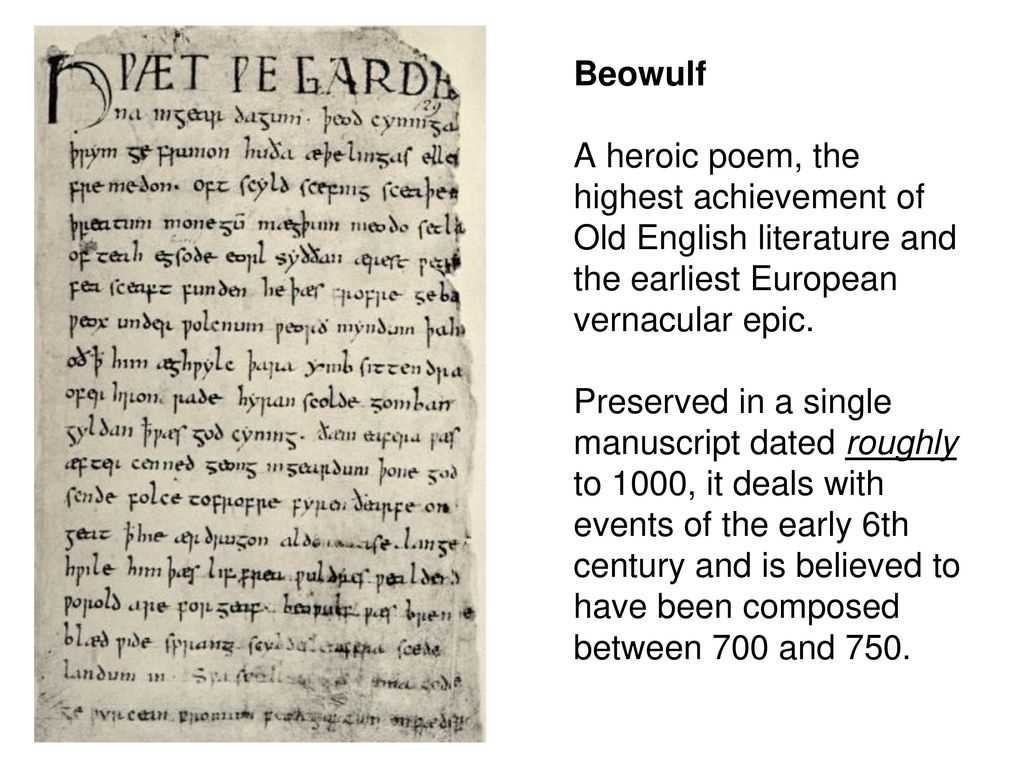
Beowulf is an epic poem that is believed to have been written between the 8th and 11th centuries. It is considered one of the most important works of Old English literature and provides valuable insights into the culture and beliefs of the Anglo-Saxon people.
The poem tells the story of Beowulf, a heroic warrior who travels to the kingdom of the Danes to help them battle a fearsome monster named Grendel. Beowulf successfully defeats Grendel and his mother, and later becomes the king of his own kingdom. The poem is divided into three main parts, each focusing on a different battle or phase of Beowulf’s life.
One of the key themes in Beowulf is the concept of heroism and the heroic code. Beowulf embodies the characteristics of a hero, including strength, courage, and loyalty. He is admired and revered by his people for his heroic deeds. The poem also explores the theme of fate, as the characters often believe that their actions are predetermined by destiny.
Beowulf also provides a glimpse into the cultural and social norms of the time. The poem describes the mead hall, an important social and gathering place for warriors, and the role of the king as a patron and protector of his people. It also showcases the importance of kinship and loyalty, as Beowulf is motivated by a desire to repay a debt of gratitude to the king of the Danes.
Overall, Beowulf is a captivating epic that offers a unique perspective on the heroic ideal and the values of the Anglo-Saxon society. It continues to be studied and appreciated for its literary and historical significance.
Historical Context: Understanding Beowulf’s Background
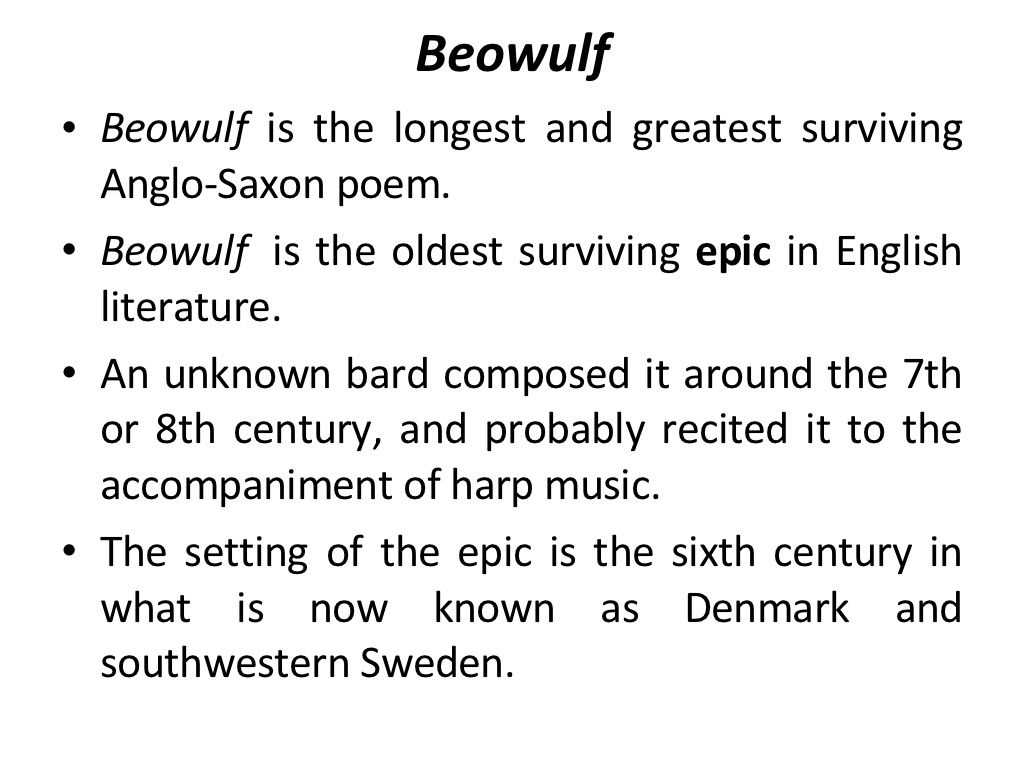
Beowulf, an epic poem written in Old English, has its roots in the early medieval period, specifically in the Early Middle Ages. The historical context in which it was composed and set plays a crucial role in understanding the background of Beowulf.
During the Early Middle Ages, much of Europe was experiencing political and social instability. This period is often referred to as the Dark Ages, as it was marked by the decline of the Roman Empire and the subsequent fragmentation of political power. The Germanic tribes, which included the Angles, Saxons, and Jutes, migrated to the British Isles, bringing with them their own oral traditions and pagan beliefs. Beowulf reflects this historical context in its portrayal of a society governed by warrior culture and the belief in fate.
The poem itself likely originated in Anglo-Saxon England, during a time when the island was divided into several separate kingdoms. These kingdoms were constantly at war with one another, and the need for heroes and leaders, such as Beowulf, was crucial for survival. The story of Beowulf, with its emphasis on heroism, loyalty, and the struggle between good and evil, resonated with the values and concerns of the time.
Table: Key Historical Events during the Early Middle Ages
| Events | Years |
|---|---|
| The fall of the Western Roman Empire | 476 |
| The migration of Germanic tribes to the British Isles | 5th and 6th centuries |
| The Viking Age | 8th to 11th centuries |
| The Norman Conquest of England | 1066 |
The historical context of Beowulf, therefore, provides valuable insights into the cultural, political, and social landscape of the Early Middle Ages. By understanding these historical factors, readers can gain a deeper appreciation for the themes and motifs present in the epic poem, as well as the significance of the hero Beowulf within his specific historical context.
Beowulf Characters: Analysis and Interpretation
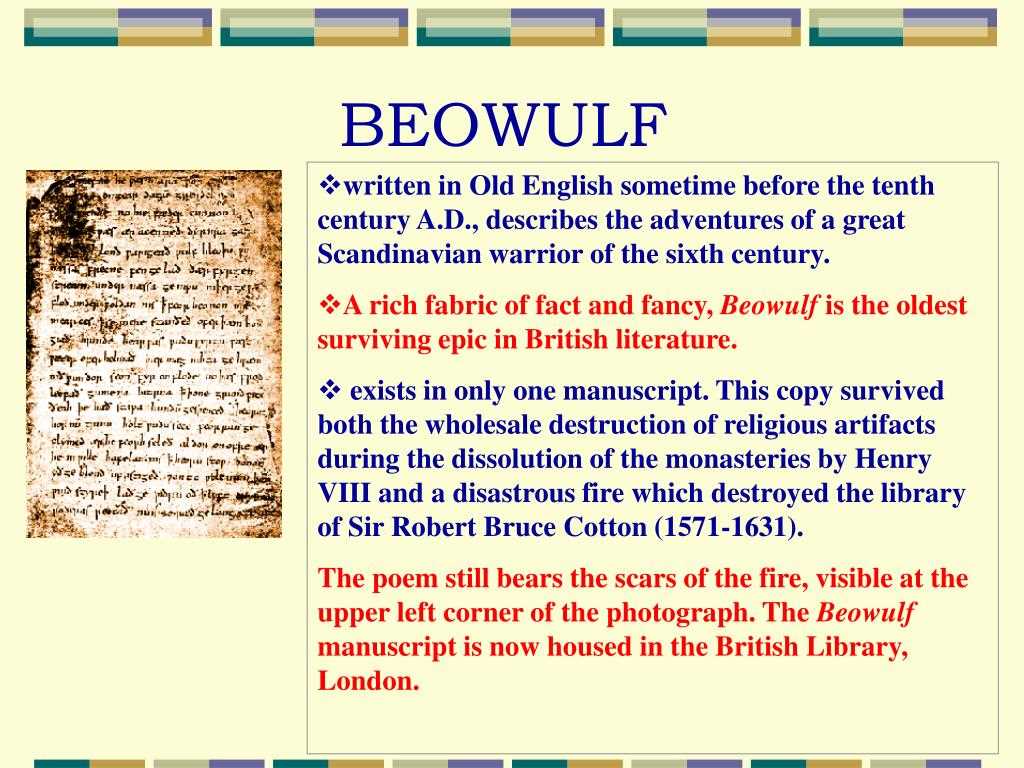
In the epic poem Beowulf, written by an unknown author, the characters play a significant role in shaping the narrative and conveying various themes. Each character has unique traits and motivations that contribute to the overall story. Here, we will analyze and interpret the three main characters: Beowulf, Grendel, and Hrothgar.
Beowulf
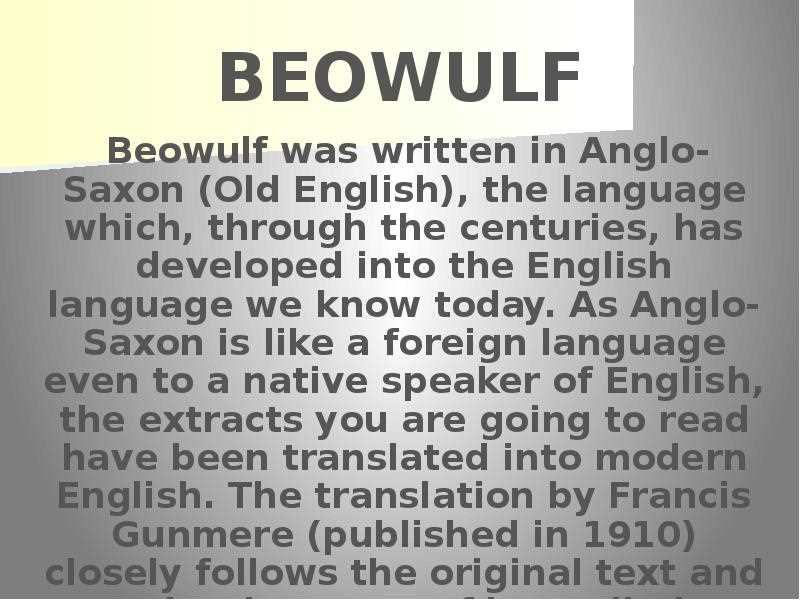
Beowulf, the protagonist of the poem, is a courageous and noble warrior. He is depicted as larger-than-life, with immense physical strength and unwavering bravery. Beowulf’s purpose is to rid the land of evil and protect his people from the monstrous creatures that threaten them. His determination and resilience make him a legendary hero.
Beowulf’s character symbolizes the ideals of Anglo-Saxon warrior culture, emphasizing bravery, loyalty, and honor. His heroic deeds, such as defeating Grendel and the dragon, showcase his exceptional abilities and his willingness to sacrifice for the greater good. Beowulf’s character arc also highlights the fleeting nature of fame and the inevitability of mortality.
Grendel
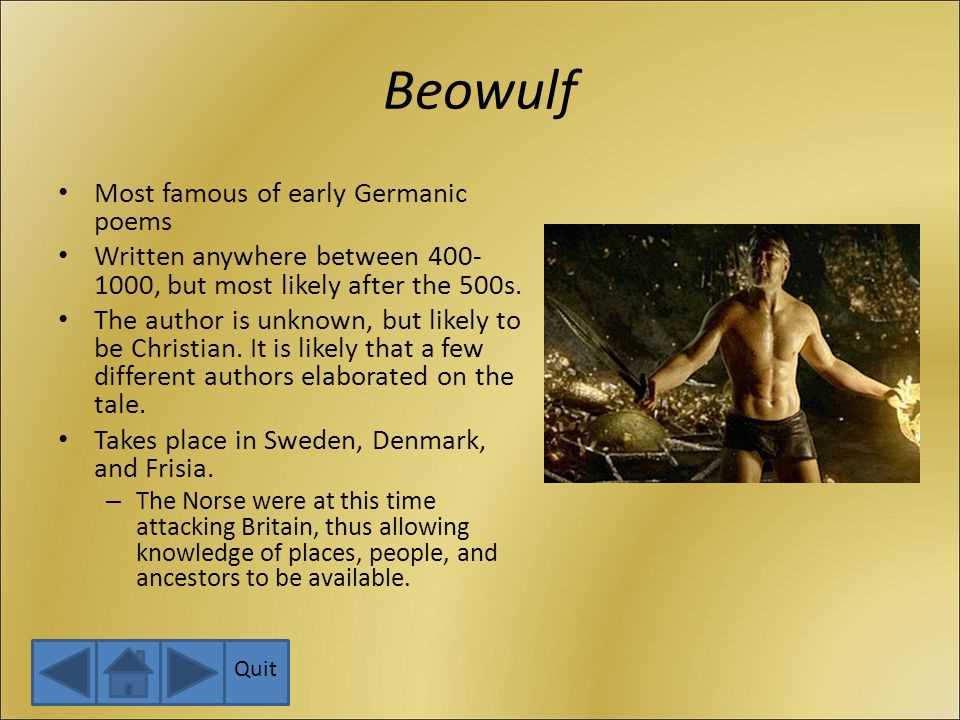
Grendel, the main antagonist of the poem, is a grotesque and bloodthirsty monster. He represents the embodiment of evil and chaos within the story. Grendel is driven by his deep-seated anger and loneliness, which leads him to terrorize the Danes in their mead hall, Heorot. Through his actions, Grendel symbolizes the dark side of humanity and the destructive consequences of unchecked aggression.
Grendel’s character serves as a contrast to Beowulf, highlighting the dichotomy between good and evil. His terrorizing presence poses a threat to the values and stability of the community, forcing Beowulf to confront him. Grendel’s defeat further emphasizes the triumph of good over evil and reinforces the poem’s themes of heroism and the importance of community.
Hrothgar
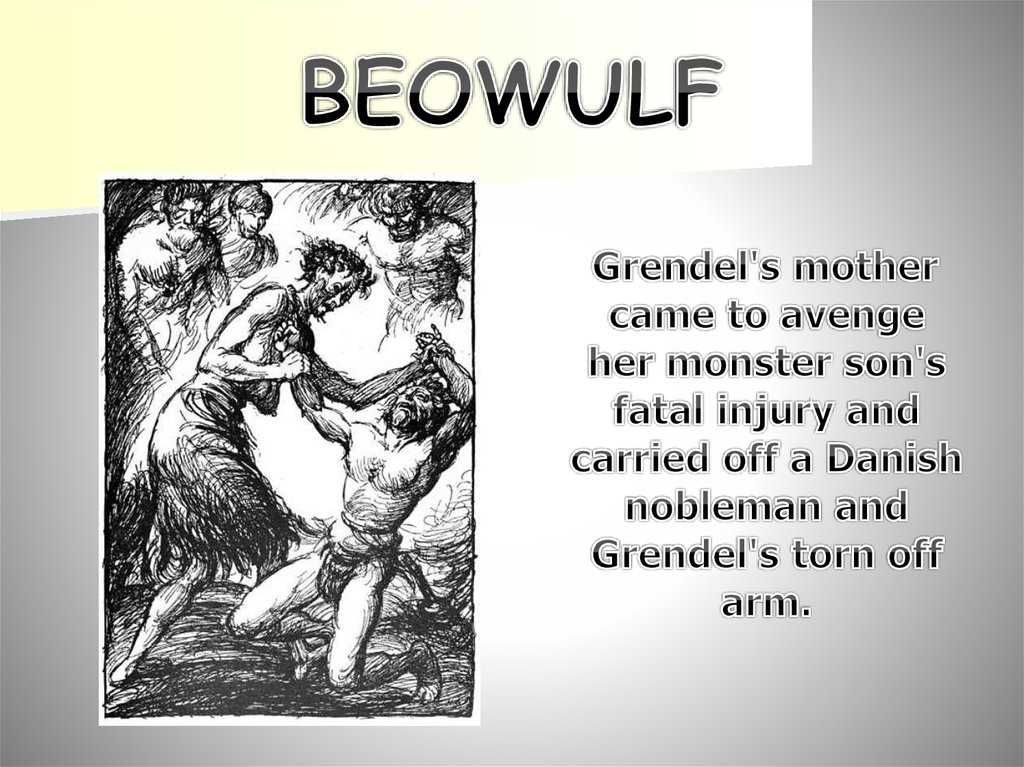
Hrothgar, the wise and respected king of the Danes, plays a significant role in the development of the story. He is portrayed as a figure of authority and a symbol of civilization and order. Hrothgar’s kingdom is under constant attack by Grendel, which leads him to seek Beowulf’s help. Hrothgar serves as a mentor and father figure to Beowulf, offering him guidance and recognition for his heroic deeds.
Hrothgar’s character represents the fragility of human power and the inevitability of aging and decline. Despite his noble stature, he is unable to protect his people from the monstrous threat, relying on Beowulf to save them. Hrothgar’s interactions with Beowulf also showcase the importance of wise leadership and the passing of knowledge from one generation to the next.
- Beowulf is a heroic warrior, representing the ideals of Anglo-Saxon culture.
- Grendel symbolizes evil and the destructive consequences of unchecked aggression.
- Hrothgar serves as a wise and respected king, highlighting the fragility of power.
The analysis and interpretation of these characters provide deeper insights into the themes and messages conveyed in Beowulf. By examining their motivations, actions, and symbolism, we can gain a better understanding of the epic poem and its significance in the context of English literature.
Beowulf’s Plot: Summary and Breakdown
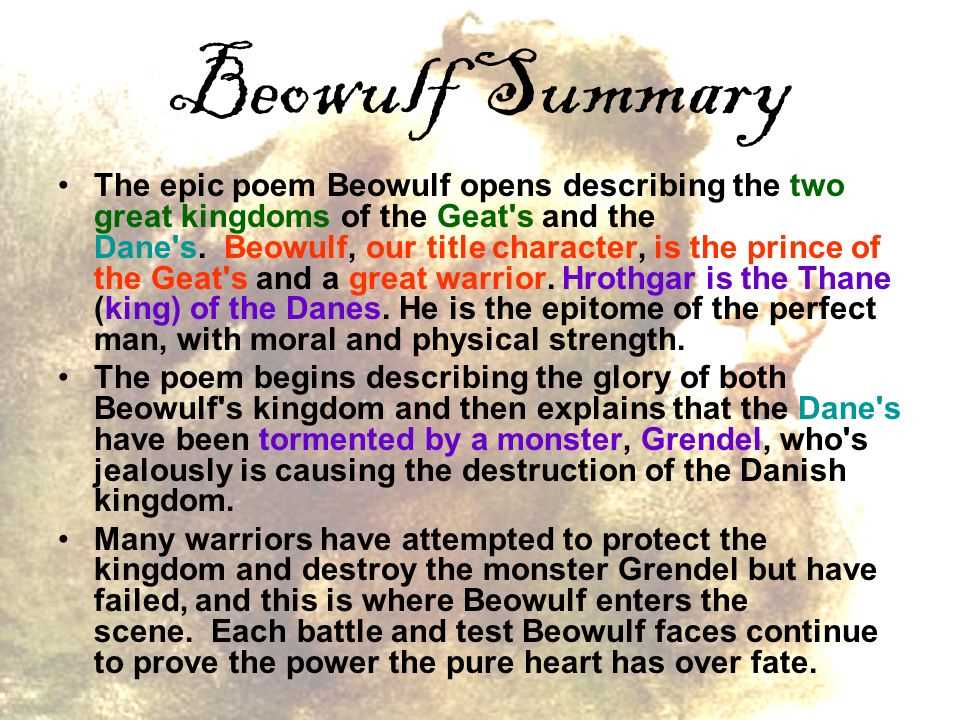
Beowulf is an Old English epic poem that tells the story of a hero named Beowulf who travels to Denmark to help Hrothgar, the king of the Danes, who is being terrorized by a monstrous creature named Grendel. The poem is divided into three main sections, each focusing on a different battle or conflict that Beowulf faces.
The first section of the poem revolves around Beowulf’s battle with the monster Grendel. Grendel, who is feared and hated by the Danes, attacks Hrothgar’s mead hall, Heorot, every night, killing and wreaking havoc. Beowulf, with his impressive strength and courage, decides to take on the challenge and confront Grendel. In a fierce battle, Beowulf defeats Grendel by ripping off his arm, causing the monster to flee in defeat.
The second section of the poem focuses on the battle with Grendel’s mother. Seeking revenge for her son’s death, Grendel’s mother attacks Heorot in the night and takes one of Hrothgar’s most trusted warriors with her. Beowulf, determined to protect the kingdom and avenge the warrior’s death, dives into a perilous underwater cave to confront Grendel’s mother. In a fierce battle, Beowulf kills her by using a magical sword he finds in her lair.
The third and final section of the poem takes place many years later and deals with Beowulf’s own battle with a dragon. Beowulf, now an elderly king, must once again defend his kingdom from a threat. The dragon, enraged after a thief steals a valuable cup from its treasure hoard, attacks the kingdom. Beowulf, determined to protect his people, faces the dragon alone. Despite his waning strength, Beowulf manages to defeat the dragon but is mortally wounded in the process. The poem ends with Beowulf’s death and a mournful reflection on his legacy and the fate of the kingdom.
Themes in Beowulf: Exploring the Central Ideas
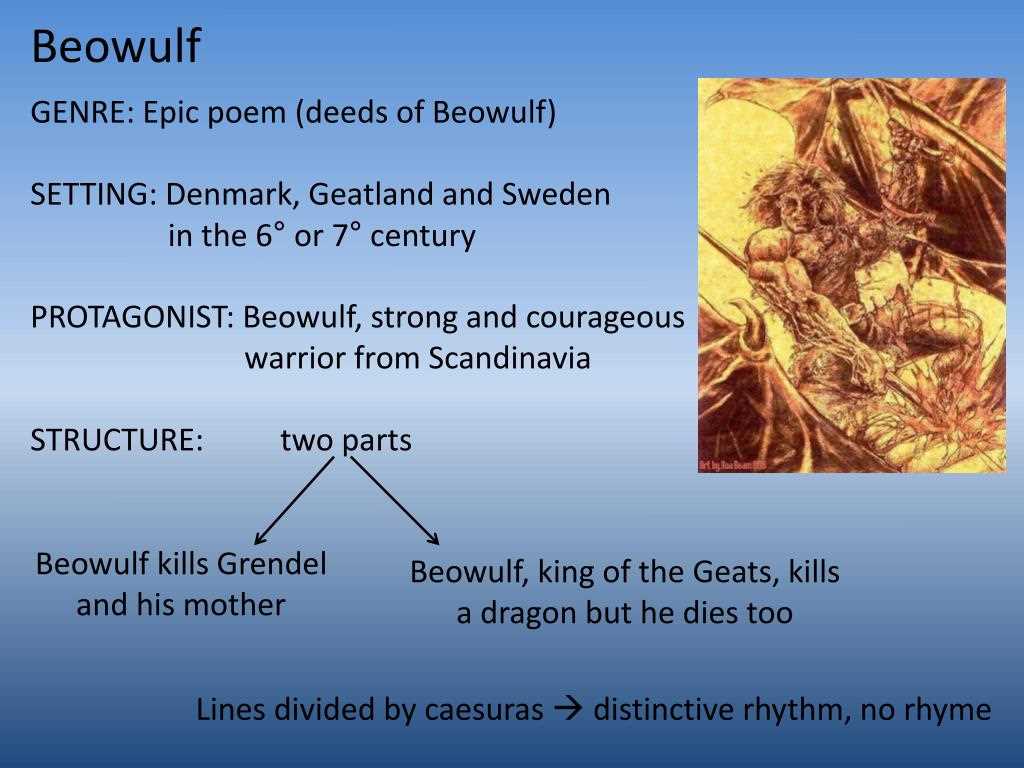
Beowulf, an epic poem from the Anglo-Saxon period, explores several central themes that are prevalent throughout the story. These themes shed light on the values and beliefs of the society in which the poem was composed and provide insights into the human condition.
1. Heroism and Heroic Ideals: One of the main themes in Beowulf is the concept of heroism. The poem glorifies the heroic actions of its protagonist, Beowulf, who embodies the ideals of courage, strength, and loyalty. Beowulf’s willingness to face dangerous monsters and his determination to protect his people make him a legendary hero. The poem also emphasizes the importance of maintaining one’s reputation and upholding the values of honor and bravery.
2. Fate and Divine Providence: Another central theme in Beowulf is the belief in fate and divine providence. The characters in the poem often attribute their successes or failures to the will of the gods. They believe that one’s destiny is predetermined, and individuals must accept their fate without question. This theme is reflected in the numerous references to God’s will and the idea that humans are ultimately powerless in the face of supernatural forces.
3. Good vs. Evil: Beowulf explores the timeless conflict between good and evil. The poem depicts a world where monstrous creatures, such as Grendel and his mother, threaten the existence of humanity. Beowulf, as the embodiment of good, confronts these evil forces to protect his people. The poem also explores the idea that evil can corrupt even the noblest of individuals, as seen in the tragic downfall of King Hrothgar’s trusted advisor, Unferth.
- 4. Loyalty and Kinship:
One of the key themes in Beowulf is the importance of loyalty and kinship. The characters in the poem are bound together by bonds of loyalty and honor, and they are willing to sacrifice themselves for their king or their fellow warriors. The poem also highlights the importance of kinship and ancestry, as Beowulf’s lineage is traced back to the first king of the Danes, and his own heroic deeds ensure the continuation of his family’s legacy.
5. Mortality and the Transience of Life: Beowulf also grapples with the theme of mortality and the transience of life. The poem emphasizes the fleeting nature of human existence and the inevitability of death. Despite his heroic achievements, Beowulf is unable to escape his own mortality, and the poem serves as a reminder of the impermanence of earthly glory. This theme is reinforced through the various funeral ceremonies and rituals described in the poem, highlighting the need to honor and remember the dead.
| Themes in Beowulf: | Heroism and Heroic Ideals | Fate and Divine Providence | Good vs. Evil | Loyalty and Kinship | Mortality and the Transience of Life |
|---|---|---|---|---|---|
| Description: | Glorifying heroic actions | Belief in predetermined destiny | Conflict between good and evil | Importance of loyalty and kinship | Reflection on mortality and impermanence |
Literary Devices in Beowulf: Analyzing the Language
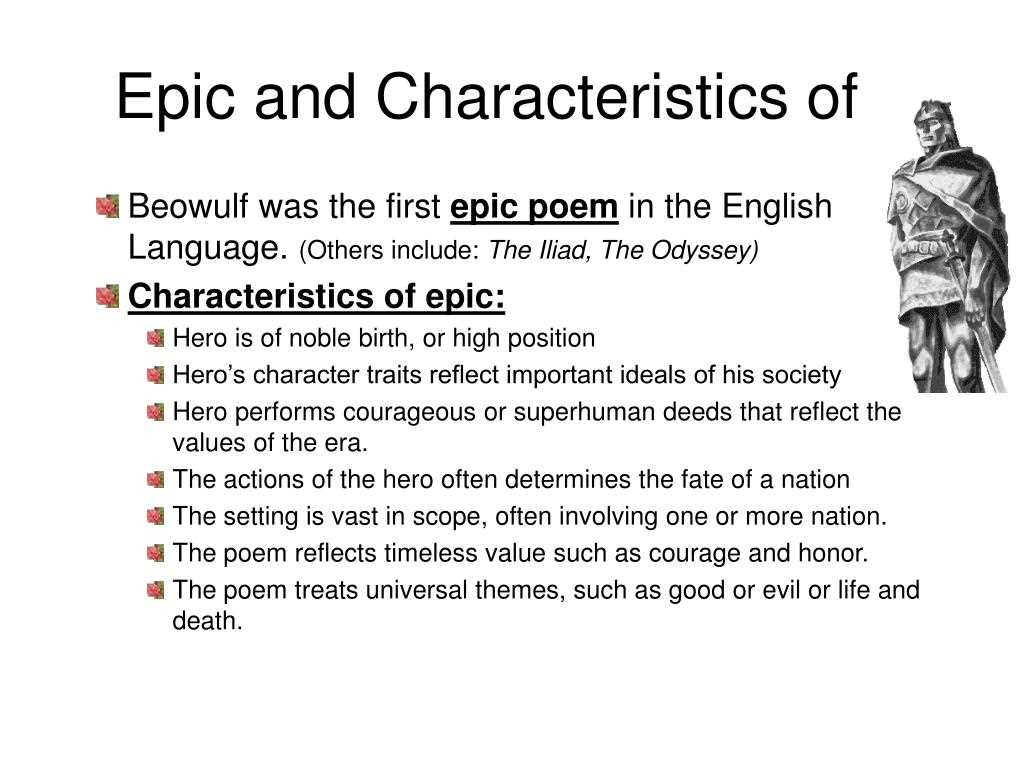
Beowulf, one of the most revered and influential works of Old English literature, is a treasure trove of various literary devices that enhance the overall storytelling experience. By examining the language used in Beowulf, readers can gain a deeper understanding of the themes, characters, and emotions portrayed in the epic poem.
The extensive use of alliteration is one of the striking literary devices in Beowulf. Alliteration, the repetition of initial consonant sounds, not only adds musicality and rhythm to the poem but also serves as a mnemonic device to aid in memorization. The prominent alliteration in Beowulf, such as “sea-streets,” “fighting fiend,” and “gory glory,” creates a captivating and immersive reading experience, allowing readers to become fully engaged with the story.
Another literary device found in Beowulf is the use of metaphor and simile. Through vivid comparisons, the poet effectively conveys complex emotions and ideas. For instance, when describing Grendel’s mother, the poet compares her to “a she-wolf from hell” and “a great water witch,” not only painting a vivid picture of her physical appearance but also suggesting her fierce and cunning nature. By employing metaphors and similes, Beowulf becomes more than just a narrative; it becomes a work of art.
- Alliteration: The use of alliteration in Beowulf adds musicality and rhythm to the poem, enhancing the readers’ engagement.
- Metaphor and Simile: The poet harnesses the power of metaphor and simile to convey complex emotions and ideas, bringing the characters and their experiences to life.